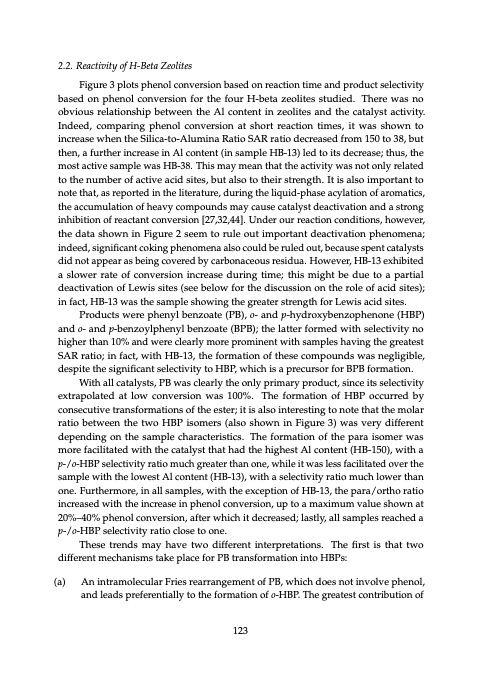
PDF Publication Title:
Text from PDF Page: 138
2.2. Reactivity of H-Beta Zeolites Figure 3 plots phenol conversion based on reaction time and product selectivity based on phenol conversion for the four H-beta zeolites studied. There was no obvious relationship between the Al content in zeolites and the catalyst activity. Indeed, comparing phenol conversion at short reaction times, it was shown to increase when the Silica-to-Alumina Ratio SAR ratio decreased from 150 to 38, but then, a further increase in Al content (in sample HB-13) led to its decrease; thus, the most active sample was HB-38. This may mean that the activity was not only related to the number of active acid sites, but also to their strength. It is also important to note that, as reported in the literature, during the liquid-phase acylation of aromatics, the accumulation of heavy compounds may cause catalyst deactivation and a strong inhibition of reactant conversion [27,32,44]. Under our reaction conditions, however, the data shown in Figure 2 seem to rule out important deactivation phenomena; indeed, significant coking phenomena also could be ruled out, because spent catalysts did not appear as being covered by carbonaceous residua. However, HB-13 exhibited a slower rate of conversion increase during time; this might be due to a partial deactivation of Lewis sites (see below for the discussion on the role of acid sites); in fact, HB-13 was the sample showing the greater strength for Lewis acid sites. Products were phenyl benzoate (PB), o- and p-hydroxybenzophenone (HBP) and o- and p-benzoylphenyl benzoate (BPB); the latter formed with selectivity no higher than 10% and were clearly more prominent with samples having the greatest SAR ratio; in fact, with HB-13, the formation of these compounds was negligible, despite the significant selectivity to HBP, which is a precursor for BPB formation. With all catalysts, PB was clearly the only primary product, since its selectivity extrapolated at low conversion was 100%. The formation of HBP occurred by consecutive transformations of the ester; it is also interesting to note that the molar ratio between the two HBP isomers (also shown in Figure 3) was very different depending on the sample characteristics. The formation of the para isomer was more facilitated with the catalyst that had the highest Al content (HB-150), with a p-/o-HBP selectivity ratio much greater than one, while it was less facilitated over the sample with the lowest Al content (HB-13), with a selectivity ratio much lower than one. Furthermore, in all samples, with the exception of HB-13, the para/ortho ratio increased with the increase in phenol conversion, up to a maximum value shown at 20%–40% phenol conversion, after which it decreased; lastly, all samples reached a p-/o-HBP selectivity ratio close to one. These trends may have two different interpretations. The first is that two different mechanisms take place for PB transformation into HBPs: (a) An intramolecular Fries rearrangement of PB, which does not involve phenol, and leads preferentially to the formation of o-HBP. The greatest contribution of 123PDF Image | Zeolite Catalysis

PDF Search Title:
Zeolite CatalysisOriginal File Name Searched:
Zeolite_Catalysis.pdfDIY PDF Search: Google It | Yahoo | Bing
NFT (Non Fungible Token): Buy our tech, design, development or system NFT and become part of our tech NFT network... More Info
IT XR Project Redstone NFT Available for Sale: NFT for high tech turbine design with one part 3D printed counter-rotating energy turbine. Be part of the future with this NFT. Can be bought and sold but only one design NFT exists. Royalties go to the developer (Infinity) to keep enhancing design and applications... More Info
Infinity Turbine IT XR Project Redstone Design: NFT for sale... NFT for high tech turbine design with one part 3D printed counter-rotating energy turbine. Includes all rights to this turbine design, including license for Fluid Handling Block I and II for the turbine assembly and housing. The NFT includes the blueprints (cad/cam), revenue streams, and all future development of the IT XR Project Redstone... More Info
Infinity Turbine ROT Radial Outflow Turbine 24 Design and Worldwide Rights: NFT for sale... NFT for the ROT 24 energy turbine. Be part of the future with this NFT. This design can be bought and sold but only one design NFT exists. You may manufacture the unit, or get the revenues from its sale from Infinity Turbine. Royalties go to the developer (Infinity) to keep enhancing design and applications... More Info
Infinity Supercritical CO2 10 Liter Extractor Design and Worldwide Rights: The Infinity Supercritical 10L CO2 extractor is for botanical oil extraction, which is rich in terpenes and can produce shelf ready full spectrum oil. With over 5 years of development, this industry leader mature extractor machine has been sold since 2015 and is part of many profitable businesses. The process can also be used for electrowinning, e-waste recycling, and lithium battery recycling, gold mining electronic wastes, precious metals. CO2 can also be used in a reverse fuel cell with nafion to make a gas-to-liquids fuel, such as methanol, ethanol and butanol or ethylene. Supercritical CO2 has also been used for treating nafion to make it more effective catalyst. This NFT is for the purchase of worldwide rights which includes the design. More Info
NFT (Non Fungible Token): Buy our tech, design, development or system NFT and become part of our tech NFT network... More Info
Infinity Turbine Products: Special for this month, any plans are $10,000 for complete Cad/Cam blueprints. License is for one build. Try before you buy a production license. May pay by Bitcoin or other Crypto. Products Page... More Info
| CONTACT TEL: 608-238-6001 Email: greg@infinityturbine.com | RSS | AMP |